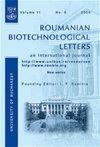Studies of Resistance to Sharka (Plum Pox) in Romanian Apricot Progenies
引用次数: 0
Abstract
Sharka (Plum pox) is considered one of the most devastating diseases of stone fruits in terms of agronomic impact and economic importance. The response of several apricot hybrids was evaluated over the vegetative period of 2010 by visual monitoring of symptom development and by serological and molecular methods. After two cycles of study, all the replicates of ‘Mari de Cenad’, ‘Traian’ and ‘Tabriz’ showed sharka symptoms while the replicates of ‘Stark Early Orange’ and NJA 2 did not show any symptoms and were not ELISA-positive. The resistant progenitors (‘Stark Early Orange’, NJA17, NJA42 and NJA2) were able to transmit PPV resistance to their descendants, in agreement with previous results (DOSBA et al, 1994, MARTINEZ-GOMEZ et al, 2000; AUDERGON et al, 1994). The genetic control hypotheses for PPV resistance in apricot referenced by different authors considered the resistance allele as dominant. Romanian apricot F1 and F2 progenies evaluated were classified into two groups: susceptible to PPV and resistant to PPV. After that the most important genotypes were grafted onto infected GF 305 (considered as indicator for PPV) in greenhouse conditions. The final step is the introduction and development of the marker-assisted selection (MAS) in PPV resistance F1 and F2 progenies in apricot Romanian genotypes. DNA was isolated from all hybrids and parent genotypes. These samples will be used to implement the molecular markers for identification of genes linked to plant response to PPV infection.罗马尼亚杏后代对酸梅的抗性研究
就农艺影响和经济重要性而言,莎卡(梅花痘)被认为是核果中最具破坏性的疾病之一。通过症状发展的视觉监测以及血清学和分子方法,对几个杏杂交种在2010年营养期的反应进行了评估。经过两个周期的研究,“Mari de Cenad”、“Traian”和“Tabriz”的所有复制品都表现出sharka症状,而“Stark Early Orange”和NJA 2的复制品没有表现出任何症状,也没有ELISA阳性。抗性祖细胞(‘Stark Early Orange’、NJA17、NJA42和NJA2)能够将PPV抗性传递给其后代,这与先前的结果一致(DOSBA等人,1994;MARTINEZ-GOMEZ等人,2000;AUDERGON等人,1994)。不同作者引用的杏PPV抗性的遗传控制假说认为抗性等位基因是显性的。罗马尼亚杏F1和F2后代被分为两组:对PPV敏感和对PPV抗性。之后,在温室条件下将最重要的基因型嫁接到受感染的GF 305(被认为是PPV的指标)上。最后一步是在罗马尼亚杏基因型的PPV抗性F1和F2后代中引入和发展标记辅助选择(MAS)。从所有杂交种和亲本基因型中分离出DNA。这些样品将用于实现分子标记,以鉴定与植物对PPV感染的反应相关的基因。
本文章由计算机程序翻译,如有差异,请以英文原文为准。
求助全文
约1分钟内获得全文
求助全文

 求助内容:
求助内容: 应助结果提醒方式:
应助结果提醒方式:


